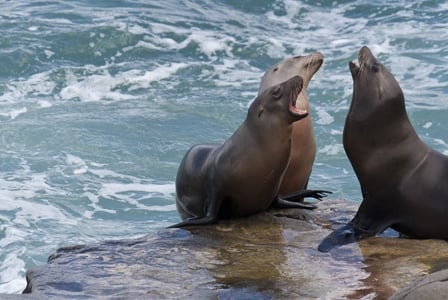
This Wildlife Wednesday, learn about the California sea lion, and how record numbers of pups are struggling to survive.
Habitat: the Pacific coastlines of North America, from Vancouver Island to Mexico—as well as a distinct population on the Galapagos Islands
Sea lion trivia
- You can tell California sea lions apart from other sea lions because they don’t have manes. They’re much sleeker—and faster—than other sea lions, such as the Stellar sea lion. However, like other sea lions, they still have a thick layer of blubber to keep them warm in cold waters.
- Sea lions belong to a classification called pinnipeds, along with seals and walruses. This group is based on their fin feet.
- Just like whales and dolphins, the sea lions’ ancestors lived on land, and then returned to the water and adapted to its aquatic environment. For instance, they can actually slow their hearts down when they dive deep into the water, allowing them to hold their breath for longer.
- When we think of the stereotypical seal balancing a ball on its nose and performing circus tricks, it’s a California sea lion we’re imagining. These sea lions are very social, intelligent, and playful—sometimes even seen riding the waves, almost like surfing.
- These sea lions’ favourite foods include fish, squid, and shellfish. Their predators include killer whales and sharks.
- California sea lions have been compared to dogs in two ways—it’s said that their faces look similar to dogs and they’re also known to “bark” loudly when in groups.
Why they’re threatened
Although their numbers are said to be growing steadily, threats to California sea lions include disease, entanglement in marine and fishing debris, malnutrition, and toxicosis from harmful algae blooms.
Recent headlines about these sea lions are a cause for concern—a record approximately 900 pups have turned up on the shores of California starving and severely underweight. Since January, the young sea lions have been turning up on beaches skin-and-bone, and as many as possible are being rescued by conservation groups. Researchers aren’t sure why this is happening, although it’s clear that the pups haven’t been able to find enough food. Federal officials are even weighing on, calling this an “unusual mortality event.”


